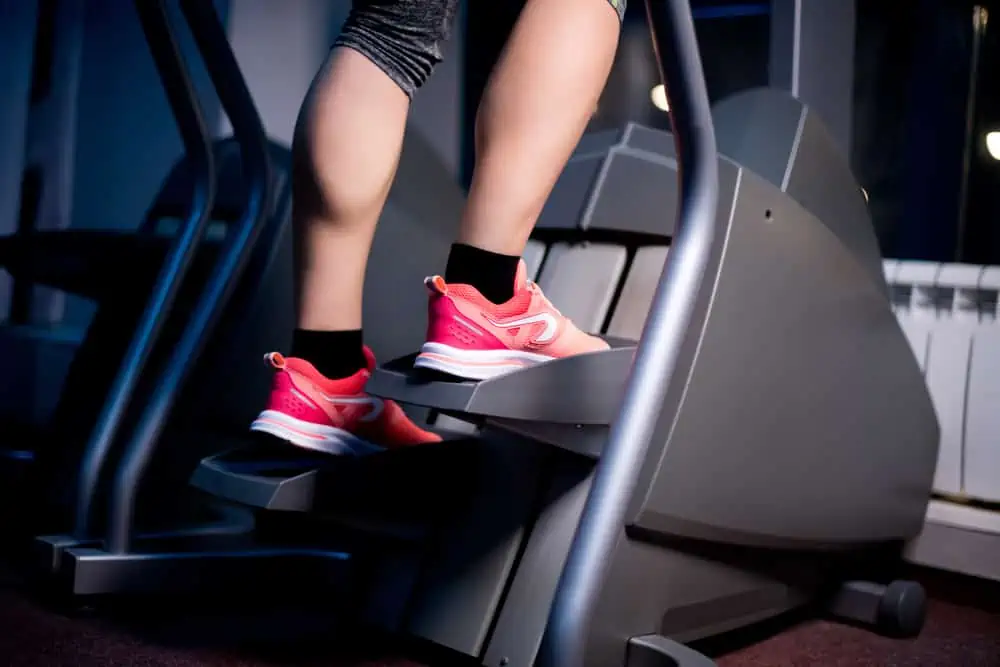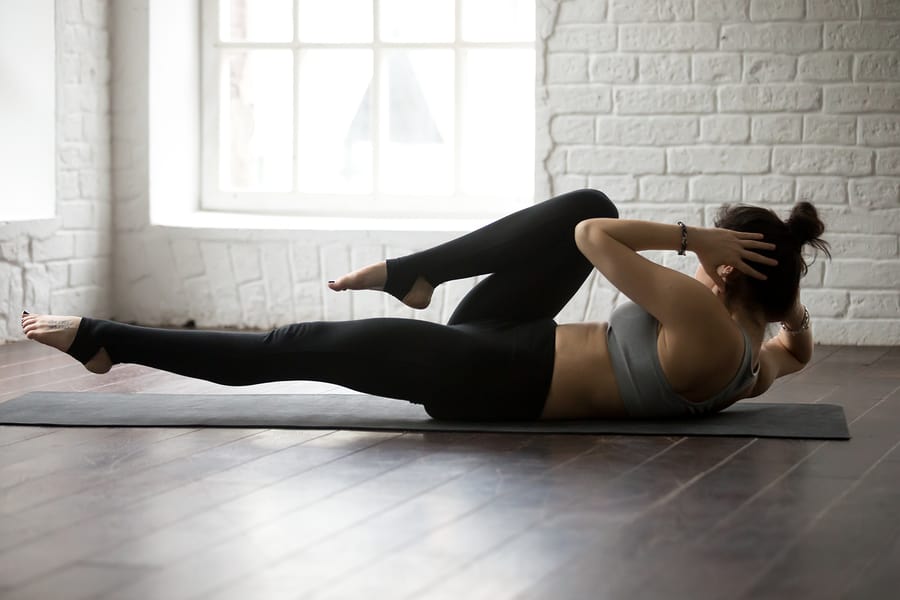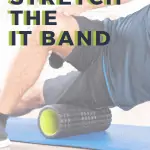This post may contain affiliate links. If you click through a link and make a purchase, I may receive a commission at no additional cost to you. As an Amazon Associate, I earn from qualifying purchases. Read the full disclosure here.
IT Band pain is a common complaint causing lateral knee pain and perception of tightness along the thigh.
Because of this, there’s an obsession to try to stretch and foam roll your tight IT band until it “loosens up.”.
Did you know there’s actually no such thing as an iliotibial band stretch (and foam rolling your ITB into oblivion also won’t fix your pain)? Unfortunately, it’s just not that simple.
Today we’re going to clear up the rumors and learn why you can’t stretch the IT Band (and what you can instead that actually works) to finally ditch tightness and pain for good.
Let’s get started!
Disclaimer: This content is for educational purposes and is not medical advice. Read the full disclaimer.
Can you stretch your IT band?
Let’s dig into a little anatomy and physiology to understand why IT band stretches are not a thing.
For starters, the IT band is short for iliotibial band. Also known as, ITB, and iliotibial tract. The name literally describes the broad area of the body this important player covers.
The iliotibial band is a thick layer of dense connective tissue that runs down the outer hip and down the side of the thigh over the vastus lateralis (one of the quadriceps muscles) to the knee.
It’s important to note that the IT band is not a muscle; therefore, it does not contract/relax like muscle tissue.

The iliotibial band covers a lot of ground and is a major stabilizing structure for the lower body.
(First hand from feeling the ITB in a cadaver lab, this puppy is like a strap that just won’t quit.)
Chaudhry H. et al. concluded the amount of force required for a 1% stretch to the ITB was somewhere around 2000 lbs and therefore, “outside the normal physiological range.” The science version of you can’t get there from here.
It wasn’t meant to stretch; it was meant to stabilize.
So there’s actually no such thing as an IT band stretch. It’s not physiologically possible.
At the pelvis, the iliotibial band attaches to a small muscle called the tensor fascia latae, or TFL.
Not only does it sound like a foamy drink at a trendy coffee house, tensor fascia latae is also super fun to say. But maybe that’s just me.
The iliotibial band also joins with fibers from the gluteus maximus (the large and powerful butt muscle.)
You can stretch the TFL and glutes – more on this coming up.
What is IT band syndrome?
Iliotibial band syndrome usually presents as lateral knee pain (outer knee) along the distal end of the IT Band. It’s a common overuse injury with runners and cyclists, or any activity that has repetitive knee flexion and extension.
ITB syndrome (sometimes called iliotibial band friction syndrome or runner’s knee) is a result of repetitive movements and a breakdown in mechanics and causes you to think your IT band is tight.
Pain is often felt around the lateral (outside) area of the knee. The TFL muscle can also spasm causing hip pain and a feeling of tightness in the outer thigh.
Related read: 7 Running Injuries & How To Prevent Them
The problem with IT band pain
Here’s the monkey wrench: as humans, we live and move in 3D.
Just because there’s pain in one area, it doesn’t mean that’s the root cause of the problem. And the reality is, what caused one person’s IT band pain may not be the cause of another’s.
There are many ways the body likes to cheat to get the movement it needs.
Several different issues can cause problems that manifest as an IT band pain, so it’s crucial to get evaluated by a physical therapist to figure out why you’re having issues.
Why does the IT band get tight?
The human body often gives the perception of tightness when there is muscle weakness or other tissue strain.
Here are some common reasons why the IT Band feels tight.
- Hip muscle weakness, especially glutes (gluteus medius and glut max) or stabilizing muscles
- Internal rotation of the leg with activity
- Lack of range of motion at the hip
- Excessive pronation of the foot increasing internal rotation of the tibia (lower leg)
- Breakdown of form when fatigued
- Overtraining, especially running or cycling
- Running on uneven surfaces
- Too much sitting
People can present differently, which is why the treatment for your brother/mother/friend/neighbor might not work for you.
So when I hear things like “stretch your ITB” or foam roll your ITB as a blanket cure-all statement, it makes me cringe.
What to do instead
This is where I do my plug for physical therapy and tell you that if you have pain, stop foam rolling your ITB and get to a PT for a proper biomechanical evaluation.
Put the pieces of your puzzle together.
While you can’t stretch the ITB, you can stretch/strengthen the muscles that attach to the ITB and have an effect on the overall alignment of the lower extremity.
Rebalance by strengthening the muscles in the area that are not pulling their fair share of the workload.
A whole host of alignment issues, weakness, or flexibility issues can be changing the forces acting on your ITB and voila. Pain.
This is what a physical therapist will help you with depending on what your particular issues are.
How to stretch the IT band
There are many stretches touted as “ITB stretches.”
Since we already covered it’s physiologically impossible to stretch, what are they actually doing?
They are stretching other hip/lower extremity muscles that attach to or are near the ITB and affect the mechanics of the leg.
So while you will likely forever hear stretch your ITB in a fitness class *sigh*, at least you understand what you’re doing and what you’re not.
Figure 4 glute stretch
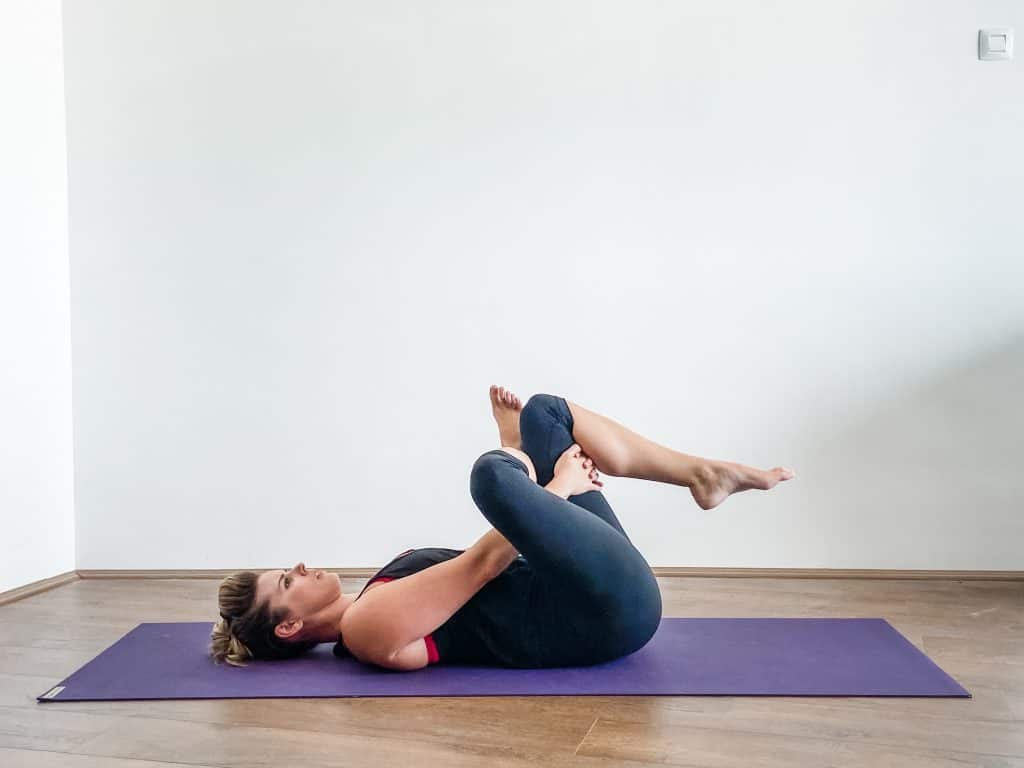
How to perform
- Lie on your back with your knees bent
- Cross right foot over the left knee and flex the foot (this helps protect the knee joint)
- This may be enough of a stretch, or you might choose to push the knee away gently.
- To intensity the stretch, you can grab ahold of the opposite leg either with your hands or a strap and draw the knee closer to your chest.
- Hold 20-30 seconds.
- Repeat 2-3 times.
Tensor fascia latae (TFL) stretch
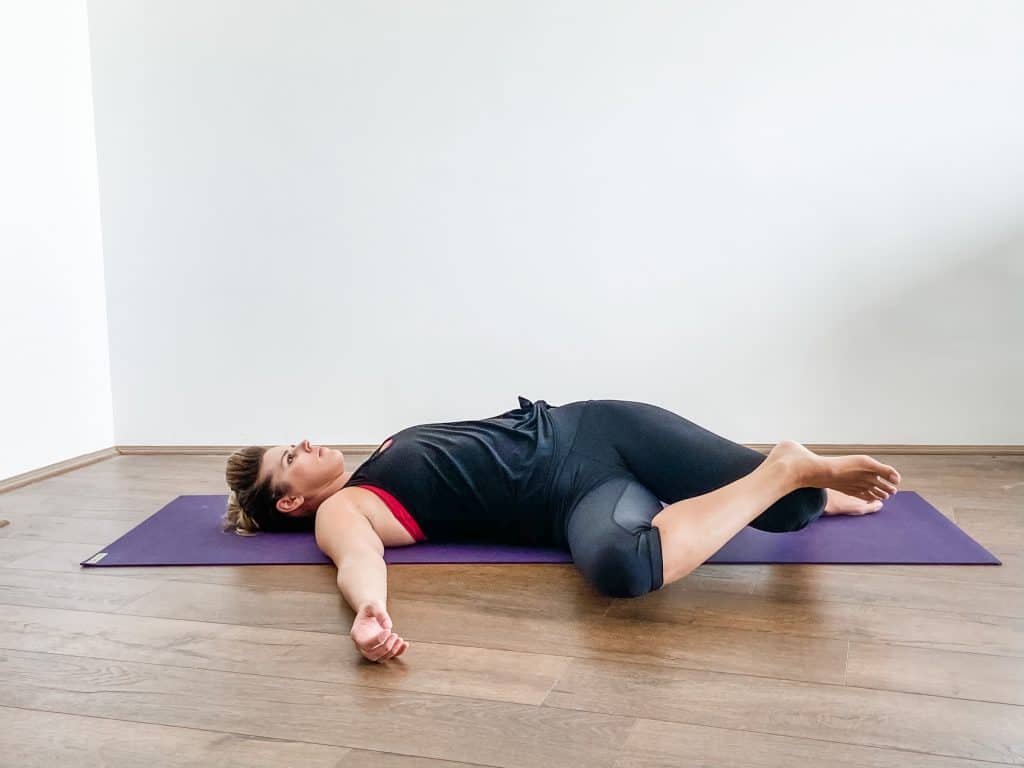
How to perform
- Lie on your back with your knees bent.
- Cross one ankle over the opposite knee.
- Drop both knees to the side.
- Hold 20-30 seconds.
- Repeat 2-3 times.
Hip flexor stretch
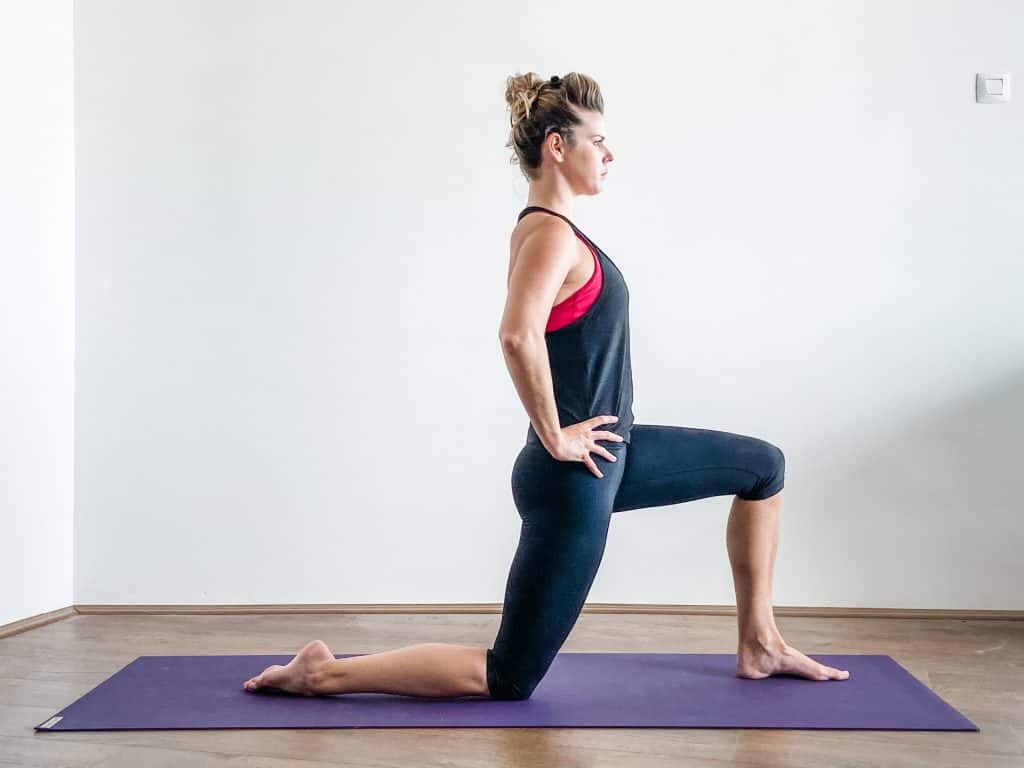
How to perform
- Kneel on a blanket for knee joint comfort.
- Step one foot forward at a 90-degree angle. (The kneeling leg will get the stretch.)
- Upright your posture and roll the pelvis under (tuck under or posterior tilt are other cues).
- Maintain this position as you translate your body slightly forward until you feel a pulling in the front of the hip and thigh.
- Hold for 20-30 seconds, keep breathing deeply.
- Repeat 2-3 times.
Quadriceps stretch

How to perform
- Set your balance either on one foot or holding on to something stable.
- Bend one knee and hold the foot or back of your shoe or attach a yoga strap and gently pull toward the glutes.
- Don’t allow the knee to move away from the body; try to keep it in line with the standing leg for best alignment.
- Hold for 20-30 seconds.
- Repeat 2-3 times.
Lumbar rotation
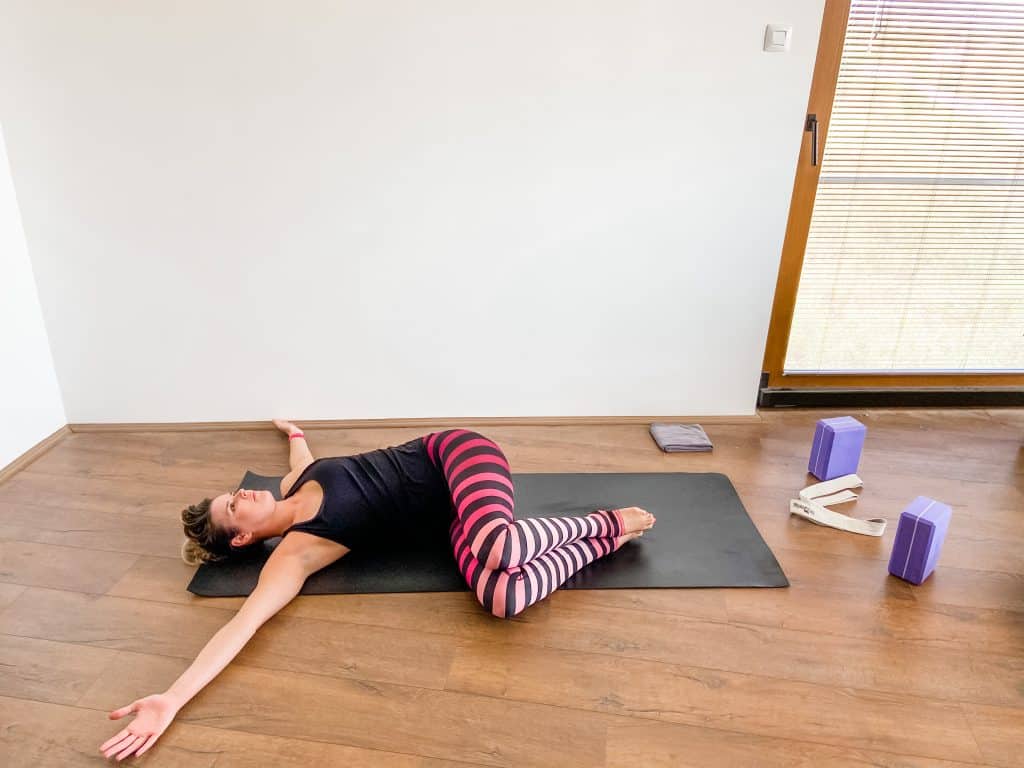
How to perform
- Decreased rotation at the lumbar spine can impact hip mobility and mechanics.
- Lie on your back with the knees bent and feet on the floor
- Arms can be extended to the sides in a comfortable range for you
- Drop your knees to one side as far as they go comfortably
- Maintain this position for 5-10 seconds and then rotate to the opposite side
- Alternate between both sides for 10-20 repetitions
Visit the hip flexibility library for more ideas and foam rolling options.
What exercises are good for IT band pain?
The body often perceives a feeling of tightness when there is muscle weakness. This perception leads you to believe you just need to keep stretching to see results.
Strengthening is often overlooked when muscles feel tight but can offer a missing piece to the puzzle.
The strengthening exercises that you need will depend on what lead to your IT Band syndrome in the first place. Weak glutes are a common finding.
There are many strengthening exercises that can benefit IT Band syndrome focusing on strengthening the glutes and other hip muscles – using good form of course!
Here are just some ideas:
- Lateral walks with resistance band
- Clam shells with resistance band
- Modified range squats
- Bridges (add a physioball or resistance band for an added challenge)
- Single leg squats and lunges
- Side plank
- Sidelying hip abduction
Is it bad to foam roll your IT band?
The general consensus is to leave an irritated IT Band alone and focus on foam rolling the structures attached to it, like the TFL and glutes.
Foam rolling can be a useful component of rehab or a general exercise program, but foam rolling an ITB alone is not going to fix or prevent issues, in fact, it could leave you feeling worse.
One of my favorite foam rollers is the Trigger Point Grid foam roller. It’s small and compact but packs a punch!
Visit the hip flexibility library for foam rolling tutorials.
How do you prevent IT band syndrome?
- Maintain a good balance of strength and flexibility, especially in key muscle groups around the hip
- Use a foam roller on surrounding muscles to keep everything mobile
- Avoid overtraining, especially with running
- Progress mileage properly and caution with uneven surfaces
- Wear proper footwear and replace at regular intervals, including inserts
- Use good form during strengthening and other exercise activities
- Don’t skip warm-ups
- Avoid “too much sitting” – Read The 7 Best Foam Roller Exercises to Combat Poor Desk Posture
Let’s stop calling things “IT band stretches”
IT band pain is more complex than it appears. If you’re stretching and foam rolling, wondering why the pain isn’t going away, you need to look deeper.
Stop trying to “stretch” the IT band and restore the proper mechanics of the tissues that caused the “tight” ITB in the first place.
So spread the word.
Related Reads:
- Hip & Spine Flexibility Library
- Anatomy for Exercise | Lower Body Muscles
- The Complete Guide to Upper Body Muscles for Beginners
- Tackle Plantar Fasciitis with these Not-So-Obvious Tips
Featured image credit: Jacob Lund / bigstockphoto.com
References and Resources
Chaundhry H, Schleip R, Ji Z, Bukiet B, Maney M, Findley T. (2008) Three-dimensional mathematical model for deformation of human fasciae in manual therapy. Journal of the American Osteopathic Association. 108(8),379-90.
Cheatham SW, Kobler MJ, Cain M, Lee M. (2015) The Effects of Self-Myofascial Release Using a Foam Roll or Roller Massager on Joint Range of Motion, Muscle Recovery, and Performance: A Systematic Review. International Journal of Sports Physical Therapy. 10(6), 827-838.
Lavine R. Iliotibial band friction syndrome. Curr Rev Musculoskelet Med. 2010;3(1-4):18-22. Published 2010 Jul 20. doi:10.1007/s12178-010-9061-8
Shamus J, Shamus E. THE MANAGEMENT OF ILIOTIBIAL BAND SYNDROME WITH A MULTIFACETED APPROACH: A DOUBLE CASE REPORT. Int J Sports Phys Ther. 2015;10(3):378-390.


